DISTRIBUTION AND DIVERSITY OF
ECUADORIAN PALMS
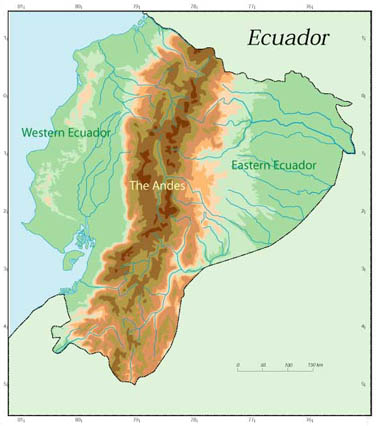
Ecuador has 31 genera and 129 native species of palms in an area of ca.
279,000 km2. In
comparison, the whole Amazon region has 151 species belonging to 34 genera
in an area covering 6.5 million km2,
or 25 times that of Ecuador. The palm flora of Ecuador corresponds roughly
to 20% of all species estimated for the Americas.
There are two main reasons
for the high species richness of the Ecuadorian flora. The
first are the varied ecological conditions found in the
country, resulting from differences in climate and
topography. Twenty six different ecological life zones,
defined by temperature and humidity according to the system
of Holdridge et al. occur in the country. Twelve of these are suitable for
palm growth. The second is the biogeographical
setting of Ecuador at the meeting point of four of South
Americas major floristic regions that for historical reasons
each have a large endemic component. These are: – to the
north-west, the pacific moist and wet forest belt in western
Colombia and Central America, often referred to as the
Chocó region; – to the south-west, the Túmbez
dry forest region in northern coastal Peru; – to the east,
the Amazon; – and in the middle of it all, the Andes
mountains traversing Ecuador from north to south.
The areas with the highest species
richness are the wet lowland rain forests in NW Ecuador and in the
Amazon where one may find 20-35 species of palms on a single
locality. In the Andes and in the dryer parts of western
Ecuador the number rarely surpass ten. The upper elevation
limit for palm growth usually lies at 2500-3000 m, depending
on rainfall (species of Geonoma and
Ceroxylon). The lower precipitation limit is ca. 600
mm per year (Aiphanes eggersii, Puyango, El Oro province).
WESTERN ECUADOR
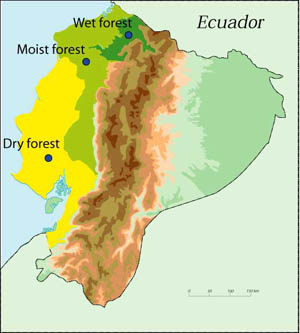
Pacific lowlands west of the Andes below 1000 m elevation cover an area of
approximately 80,000 km2, or ca. 1/3 of the total surface of
mainland Ecuador (excluding the disputed territories in the Amazon). Fifty palm
species are known to western Ecuador, including twenty-two that occur in no
other part of the country. Four species and one variety are endemic.
The most prominent factor
influencing the vegetation of western Ecuador is the
existence of a strong precipitation gradient from the
north-east to the south-west, caused by the flow of two
major ocean currents that control the climate of the entire
western South America. Areas influenced by the warm El
Niño current experience high air and water
temperatures while areas influenced by the cold Humboldt
current flowing north from the Antarctic experience low air
and water temperatures, resulting in very small amounts of
precipitation. Thus the annual rainfall in western Ecuador
ranges from more than 5000 mm in the north-east to less than
500 mm in the south-west, and along this gradient a series
of ecological life zones are found, including wet, moist,
dry, and very dry forest, each with their own characteristic
palm flora.
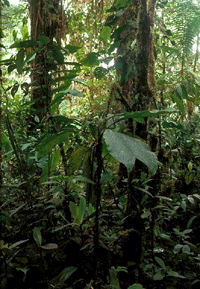 |
| Wet pre-motane forest near Lita, NW Ecuador, with Aiphanes macroloba in the foreground |
The wet forest
region occupies the interior of the province of
Esmeraldas plus a narrow strip along the Andean foothills
south to the latitude of Quevedo. The northern part of this
region, which receives more than 4000 mm precipitation, is
floristically the most diverse part of western Ecuador. A
total of 35 palm species have been recorded here, and
usually 15-20 species can be found on a single locality. A
very characteristic species for these areas is Wettinia
quinaria, which may often be dominant in the vegetation;
other common ones include Iriartea deltoidea,
Oenocarpus bataua, Socratea exorrhiza, and
Bactris setulosa. In the understorey, Geonoma
cuneata is often very abundant. A number of species
distributed in the Chocó biogeographical region have
their only occurrence in Ecuador here: examples of such
species are Geonoma congesta, Asterogyne
martiana, Aiphanes macroloba, Bactris
hondurensis, Aiphanes gelatinosa and A. hirsuta. Along small rivers and streams, the rheophytic
Geonoma linearis can be found, and in the river side swamps
in low lying areas Euterpe oleracea forms nearly
monospecific stands. In the southern part of the region palm
species richness is lower, with 7-15 species found in a
single site. Moderate species richness is,
however,counter-balanced by high numbers of individuals.
Palm dominance may be particularly pronounced in forest
patches in the Andean foothills influenced by local cloud
formation such as the low mountain ridge at Montañas
de Ila, where 1578 adult or juvenile individuals plus ca. 3000
seedlings, belonging to 12 species of palms have been recorded in a single
transect of 0.1 hectare. A typical
species of the premontane wet forest in western Ecuador is
Aiphanes erinacea, which almost always is present,
though usually at low densities.
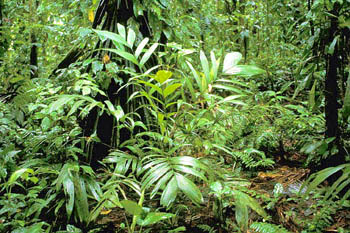 |
| Moist forest near Sto. Domingo de Los Colorados with the endemic species Geonoma irena |
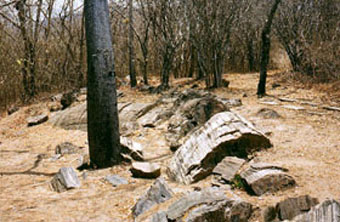 |
| The petrified forest at Puyango, with 600 mm annual precipitation the driest habitat in Ecuador where native palm species have been registered |
The moist forest region, encompassing the
life zones of tropical and premontane moist forest, forms a broad belt from San
Lorenzo in the north to Quevedo in the south, where it becomes a narrow strip in
the premontane zone that continues almost to the Peruvian border. The original
area occupied by this forest zone was ca. 32,000 km2 of which less than 4% is
estimated to remain due to human settlement and cultivation of the land. It is a
zone known to house many endemic species including four palms:
Attalea colenda, Phytelephas aequatorialis,
Geonoma irena, and G. tenuissima. In the border areas
with the wet forest region Wettinia aequalis, or in some areas Welfia
regia, typically replaces W. quinaria as forest dominant. Otherwise, the most
characteristic species of the region are Attalea colenda, Astrocaryum
standleyanum, and
Phytelephas aequatorialis, the vegetable ivory palm. In
addition, the widespread Iriartea deltoidea,
Oenocarpus bataua, Socratea exorrhiza, and
Bactris setulosa are found. Important understorey palms include
Geonoma cuneata and particularly
Synechanthus warscewiczianus, which may be dominant in the shrub
layer.
The
dry forest region, including
the lifezones of tropical dry to very dry forest and premontane dry forest, is
the least diverse as far as palms are concerned. Where precipitation in lowland
areas is less 2000 mm per year and a marked dry season appears, only few palms
are able to persist. Typical species include Syagrus sancona, Bactris
coloniata, B. gasipaes var. chichagui, and
Aiphanes eggersii, the latter being the palm species that grows
in the driest habitats. Exact data on the density of palms in this zone are not
available, but in general palms are far less important than in the more humid
forest types.
THE ANDES
The highland areas above 1000 m
elevation occupy approximately 70,000 km2, or one-quarter of Ecuador’s
territory. In the northern part of the country the Andes form two
distinct cordilleras separated by a broad inter-Andean valley. Here the
mountains are topped with a series of volcanoes, several of which are
more than 5000 m high and permanently covered with ice and snow. In the
southern part of the country the western cordillera forms a series of
lower hills and isolated small mountain ranges separated by valleys
where the climate is rather dry due to the influence of the Humboldt
current. The eastern cordillera, however, forms a fairly well defined
range with peaks up to ca. 4500 m and receives high amounts of rainfall
all year round. Due to the effect of rain shadow, most of the
inter-Andean areas have a climate that is too dry for palm growth and
in addition these valleys have been densely colonized by human beings
for thousands of years why virtually no natural vegetation is left.
 |
| The quito palm, Parajubaea cocoides in front of an old hacienda |
A characteristic palm in these areas is
Parajubaea cocoides, a domesticated species not known in the wild
but commonly planted near houses and in villages throughout the
inter-Andean valleys. Otherwise, native palms in the Andes are
essentially limited to two narrow strips, one on each the two outward
facing slopes between 1000-2500 m elevation, or occasionally up to 3000
m where rain fall is high. The absolute elevation limit recorded for a
native palm species in Ecuador is 3500 m (Ceroxylon parvifrons),
but that record is quite exceptional.
Due to the colder climate, palm
species richness is lower in the mountains than in the adjacent lowland
areas. Nevertheless, palms are often quite dominant in the vegetation,
especially at mid-elevations. Examples of species that may be locally
dominant in montane forest include Dictyocaryum lamarckianum,
and especially species of the genus Ceroxylon, but also
understory palms can be extremely abundant. In one example, the
Ecuadorian ecologist Renato Valencia found 796 individuals of
Geonoma undata with a stem more than 5 cm in diameter in one
hectare of wet forest near Baeza on the eastern slopes of the Andes in
Ecuador, at ca. 2000 m elevation. In southern Ecuador, exposed ridges
with a shrubby vegetation and a dense ground cover of terrestrial
Bromeliads, found at elevations from 2000-2800 m, house an unexpectedly
rich palm flora including Aiphanes verrucosa, Ceroxylon
parvifrons, C. vogelianum, Geonoma densa,
G. orbignyana, G. weberbaueri, and a curious form of
Prestoea acuminata with red leaf sheaths and narrow, leathery
pinnae.
In total, the Ecuadorian Andes has 15
genera and 50 species, of which 26 are ‘true’ mountain palms in the
sense that they do not occur below 1,000 m elevation. Five of these,
including two endemic ones (Aiphanes chiribogensis, A.
grandis), are restricted to the western slopes, while sixteen
species, including five endemics (Aiphanes verrucosa,
Ceroxylon parvum, Hyospathe macrorachis,
Wettinia minima, W. aequatorialis), occur only on the
eastern slopes. The last five are trans-Andean.
EASTERN ECUADOR
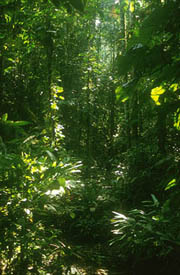 |
| Terra firme rain forest in E Ecuador |
The areas below 1000 m elevation east of
the Andes constitute approximately 40 % of the total area of the
country. It is the most diverse region, both with respect to total
number of palm species found, and to the number of species that can be
found growing together on a single site. Sixty species, or almost half
the palm species of the country, occur in this region, including 40
species that in Ecuador occur only here. Important genera include
Geonoma and Bactris, which are far most diverse here. Of
interest is also the lianescent genus Desmoncus, which has four
of its five Ecuadorian representatives in the eastern lowlands. In
contrast to the western part, eastern Ecuador is relatively homogeneous
with respect to climate. Rain fall varies from 3,500 to 5,000 mm per
year, with the highest values being reached close to the Andes in the
central part of the region, but floristic differences correlated with
the precipitation pattern are not evident. Instead, the eastern
lowlands contain a mosaic of non-flooded, more or less well drained
terra firme land, and various wetland areas including: permanently
waterlogged swamps; regularly inundated, nutrient rich flood plains;
and nutrient poor, black water swamps that often experience prolonged,
seasonal inundation.
The terra firme forest
is the by far the most diverse formation. Thus in the Yasuní National
Park, 22-27 species have been found together in small plots of just
0.25 hectare of this forest type. Palms are also quantitively
important, as shown in studies of forest composition and structure
where the most common tree species were the palms Iriartea deltoidea
and Oenocarpus bataua, respectively. Other characteristic
species include the widespread canopy palms Astrocaryum chambira
and Attalea maripa, together with understorey species such as
Aiphanes ulei,
Chamaedorea pauciflora, Geonoma macrostachys,
G. maxima, and Hyospathe elegans. The large liana palm,
Desmoncus giganteus, also occurs here.
Permanent swamps are
usually dominated by Mauritia flexuosa, and forests consisting
almost entirely of that species cover vast areas of the Amazon.
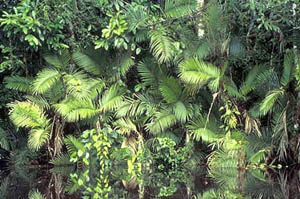 |
A dense stand of |
Species typical of flood plain
forest include Geonoma brongniartii and Bactris concinna.
Astrocaryum urostachys,
Euterpe precatoria, and Phytelephas tenuicaulis are often common
in flood plain forest, but these species are equally frequent on terra
firme and can not be said to be typical of a single forest type. In
contrast, Attalea butyracea occurs only in nutrient rich
floodplain forest and is thus typical of that habitat – it is, however,
not always present. Where it occurs, it is usually dominant.
Black water swamps
are nutrient poor, and often exposed to prolonged inundation. Species
typical of seasonally inundated black water swamps are Astrocaryum
jauari and Bactris riparia. The first occupies a narrow,
well defined zone along black water rivers and lakes, probably
corresponding to a certain minimum and maximum length of inundation.
Unique adaptations of this species to its habitat include fish
dispersal of the seeds and physiologically determined tolerance to
prolonged inundation in seedlings. Bactris riparia occurs in
deeper water than Astrocaryum jauari, often in more or less
permanently inundated areas, where it is able to propagate vegetatively
through formation of new shoots from the base of the stem. Also
Mauritiella armata occurs in black water swamps, but its
occurrence is more sporadic. It may be found on the shores of small
nutrient poor lakes, where water levels are not subject to major
seasonally determined variations.
Latest posts by admin (see all)
- Aluminium Rattan Garden Furniture Design Ideas - September 11, 2019
- Popular Gardens and Parks in Sheffield, United Kingdom - September 18, 2018
- How New Eco-Friendly Garden Benches Help Plants and Consumers in the UK - February 26, 2018



Discussion: